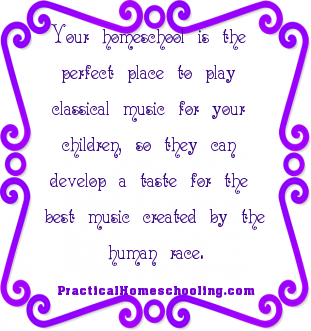 It is impossible for me to convey how much joy and pleasure classical music has given me over my lifetime. The works of Mozart, Beethoven, Bach, Brahms, Debussy, Tchaikovsky, Saint-Saens, Elgar, Ravel, Mendelssohn, Berlioz, and many, many more have filled my life with untold hours of exquisite music that reaches down into my soul. And your homeschool is the perfect place in which you can play some of this great music for your children, thus helping them develop a taste for the best music created by the human race. You must do this early if you don't want them to be dragged down into the culture of Heavy Metal, Hip Hop, Rap, and other genres in which "attitude" and noise replace musical beauty.
It is impossible for me to convey how much joy and pleasure classical music has given me over my lifetime. The works of Mozart, Beethoven, Bach, Brahms, Debussy, Tchaikovsky, Saint-Saens, Elgar, Ravel, Mendelssohn, Berlioz, and many, many more have filled my life with untold hours of exquisite music that reaches down into my soul. And your homeschool is the perfect place in which you can play some of this great music for your children, thus helping them develop a taste for the best music created by the human race. You must do this early if you don't want them to be dragged down into the culture of Heavy Metal, Hip Hop, Rap, and other genres in which "attitude" and noise replace musical beauty.
Classical music is one of the greatest achievements of Western civilization. It represents a high point in creative genius, the ability to combine beautiful melody and rhythm to create exquisite sound with a variety of instruments. If you've ever sat in a symphonic hall spellbound by the sound coming from the orchestra, you understand the power that music can have over a human being and the lifelong pleasure and emotional nourishment it can provide.
You don't need a costly stereo system to teach a love of music. When I was in the third grade, our teacher used a hand-cranked Victrola to play the records she used to teach music appreciation. Of course, since then technology has given us vastly improved playing and recording devices. An inexpensive boom box with a combined audiocassette and CD player will do.
First, play short melodic pieces. At Barnes & Noble I found such collections as: The Best of Bizet; Debussy's Greatest Hits; The Best of Gilbert & Sullivan; Wagner's Greatest Hits; Mozart's Super Hits; and Essential Mozart (32 of His Greatest Masterpieces). The most popular pieces for children are: The William Tell Overture by Rossini, which includes the "Lone Ranger" theme; the "Minute Waltz" by Chopin; "The Flight of the Bumble Bee" by Fritz Kreisler; and "The Swan" by Saint-Saens. You may want to play Saint-Saens' Carnival of Animals in its entirety. It demonstrates how animals can be portrayed musically with an ingenious and amusing use of different instruments.
Girls will greatly enjoy listening to Tschaikovsky's Sleeping Beauty, Swan Lake, or The Nutcracker ballet suites, and may even try dancing to them. The "Sorcerer's Apprentice" by Paul Dukas tells a humorous story in music. Boys will probably enjoy Gustav Holst's "Jupiter," with its brilliant, spine-tingling drums, percussion, and brass orchestration.
If you're on a strict budget, you may be able to borrow these CDs at your public library. Some libraries have extensive collections of classical music.
Of course, the best way to introduce a child to good music is to have him or her learn to play an instrument. [See the Simply Music and Davidson Music ads on pages 3 and 60, respectively, for two easy-to-teach piano courses designed for home instruction. - Editor] The piano is probably the most popular instrument. But there are also the violin, cello, bass, French horn, trumpet, harp, drums, etc. [Homespun Video has DVD and VHS courses for most folk instruments - see their ad on page 59. - Ed.]
Learning to play a musical instrument proficiently, of course, takes lots of time and practice. If the child is musically inclined and willing to make the effort, mastering an instrument can expand all kinds of horizons in that child's life. But you don't have to play an instrument in order to enjoy classical music or any other good music. And, of course, there are the electronic instruments, which may be worth looking into.
By the way, I am not against popular music. I enjoy the popular songs I grew up with, such as the songs sung so compellingly by Frank Sinatra, in which every word is carefully enunciated so that the power is not only in the music but in the words themselves.
I am also very fond of Brazilian music, the Bossa Nova, and the lilting rhythms of Brazilian jazz as played by Walter Wanderly, the brilliant jazz organist. In other words, I am in favor of a child developing a taste for all forms of good music.
There are also books about the different instruments used in an orchestra, their origins and development and how they are able to create beautiful sound in a variety of forms: the sweetness of the violin, the wondrous sound of the piano which can hardly be described, the sounds of horns, drums, the harp, the cello, the viola. Great musicians learned how to use these instruments to convey all kinds of emotions and images that soothe the soul and delight the temperament.
Learning to enjoy and appreciate good music can be a tremendously exhilarating experience, especially when it involves the entire family. But the beauty of the musical experience is that it can also be enjoyed alone no matter what the circumstance of one's life. It remains a calming companion in times of grief or loss, or an emotional stimulant in times of triumph and success.